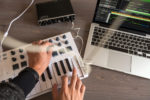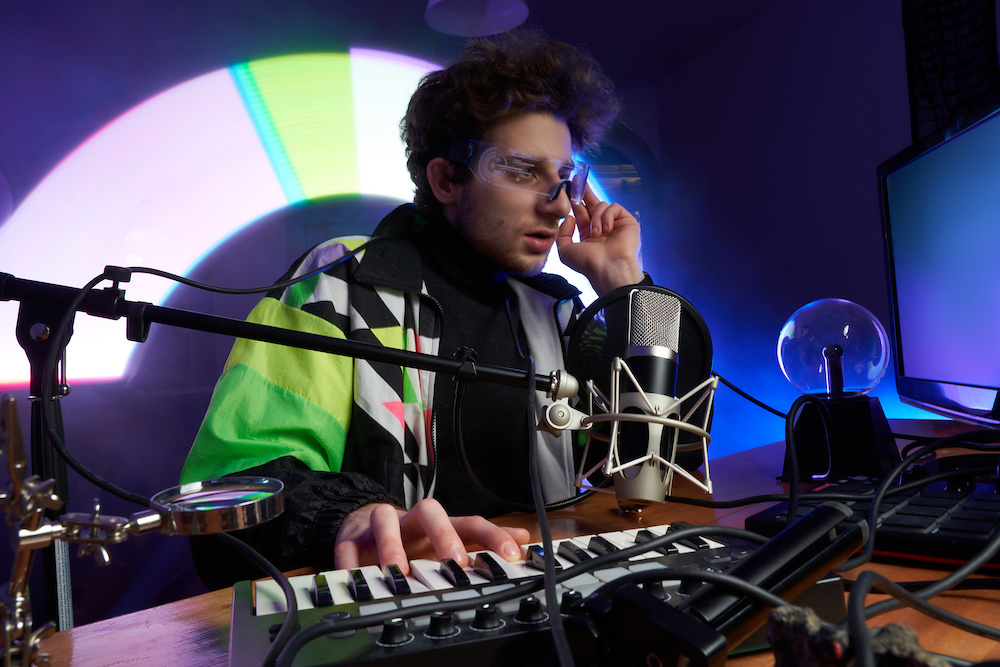What Is a MIDI Keyboard?

Most bedroom musicians own a MIDI keyboard when they started out, but what is a MIDI keyboard?
How does it help you make music? Are MIDI keyboards affordable?
These are just some of the most common queries among beginners curious about MIDI keyboards.
Hence, we decided to talk about MIDI keyboards at length and answer all your questions so that you can decide whether this controller is for you or not.
What Is a MIDI Keyboard?
A MIDI keyboard is a piano-like device that you can attach to your laptop or computer, typically with the help of a USB cable.
Most of the MIDI keyboards on the market don’t actually make any sound by themselves.
Its job is to send all the MIDI data to the computer onto the music-making software.
The real musical notes will be generated with the help of different kinds of software, such as virtual instruments or VSTi, plugins, Kontact libraries, and more.
For example, if your laptop has a virtual piano VSTi installed on it, you will be able to use the MIDI keyboard to play it in real-time, similar to playing a real piano.
The only difference here is that your software will generate the sounds.
You will also be able to control it through the MIDI keyboard, unlike an actual piano wherein you are playing it in the real world.
A majority of hardware synthesizers and regular keyboards work as a MIDI keyboard, too.
Chances are, the keyboard you own may already have a MIDI-out that will allow you to connect it to your computer.
A lot of MIDI keyboards come with sliders and knobs that can control various parameters of your virtual instruments by programming them.
For instance, if there is a volume slider in your virtual synth and you are looking to control it in real-time, you can route it to either one of the knobs or sliders on the MIDI keyboard.
In doing so, you will be able to tweak your synth whenever you like.
Which MIDI Messages Are Used With MIDI Keyboards?
Two of the most common MIDI messages used with MIDI keyboards are the MIDI notes and MIDI CC.
Both of these MIDI messages can send data, but the way they behave differs.
MIDI notes are like a light switch, which means it can either be turned off or on.
On the other hand, MIDI CC is like a dimmer that will allow you to send a range of MIDI data.
This is typically used for things like patch changes, volume, modulation, and foot pedal control.
Connecting the MIDI Keyboard to the DAW
Now that you have a better understanding of MIDI keyboards and how they function, let’s talk about how you can connect your MIDI keyboard to your DAW.
While we have listed the steps below, it is advisable that you check your DAW’s user manual for any specific information or instructions about MIDI routing.
Connecting Your MIDI Keyboard via USB
To connect a MIDI keyboard is fairly easy, simply take your USB wire and connect it to the keyboard and you can start playing.
Based on your MIDI keyboard model, there’s always a possibility that you may have to install some necessary software before connecting the controller.
Take a look at your keyboard’s user manual for additional information, such as firmware, driver software, and any power requirements.
Follow these simple steps to connect your MIDI keyboard.
- Download and install your MIDI keyboard’s driver software if you have not done it already.
- Connect your MIDI keyboard via USB, either to the computer directly or by using a powered USB hub.
- Lastly, configure the DAW with your MIDI keyboard.
Connecting Your MIDI Keyboard With MIDI Cables
The MIDI cable is capable of sending data in only one direction.
You have to ensure that you are connecting the MIDI output port to the proper MIDI input port.
If not done correctly, there will not be any MIDI data transferred.
The steps to connect the MIDI keyboards with MIDI cables are:
- Connect the five-pin MIDI cable to the MIDI IN port of your external hardware from the MIDI OUT port on the keyboard.
- If you are connecting more than one device, connect the MIDI cable from the MIDI THRU port on the first device to the MIDI IN port on the next one.
- If applicable, connect the MIDI cable from the MIDI OUT port on your last external device to the MIDI IN port to an audio interface or MIDI interface.

Can You Make Music Without a MIDI Keyboard?
Many musicians, especially new and young artists, cannot afford musical instruments, including a MIDI keyboard.
While having a MIDI keyboard definitely has its own advantages, you can make music without one, too, as long as you have a functional computer and appropriate software.
Most DAWs come with a note view, which is mostly called the piano roll, where you will be able to place notes with the mouse or trackpad one by one.
Furthermore, many DAWs, such as FL Studio, comes with a built-in option for you to use the computer’s keyboard as a replacement for the MIDI keyboard.
You can set a specific button on your keyboard to play a certain musical note.
For instance, you can set the letter “C” on your computer’s keyboard to play the musical note C, the letter “D” to play the note D, and so on.
Once you are done setting your keys, you can start playing melodies with the mapped keys. This will let you create a whole song.
It is possible to make music without a MIDI keyboard on your computer.
That said, the feeling is very different when you are doing so on a real MIDI keyboard.
For this reason alone, we recommend buying a MIDI keyboard as soon as you can afford one. Let us tell you why.
Why Should You Still Get a MIDI Keyboard?
Playing bass lines and melodies live with a MIDI keyboard controller will give it more of a “human touch” compared to programming the same on a computer keyboard.
Furthermore, you are most likely to learn playing the piano in time, so it is a natural progression, which means the sooner you do that, the better.
If you are already good at playing the keyboard or piano, then you already have a headstart.
In such cases, the MIDI keyboard is an absolute must for you.
This makes creating music a whole lot more fun and also much more efficient.
While you can program with your computer keyboard and mouse, the entire process is quite time-consuming, and you may even lose interest in it.
Additionally, if you are already used to the feel of piano keys and the instant musical feedback you’re getting from it when you play, you will get quickly frustrated if you try to create melodies with a computer mouse.
What Type of MIDI Keyboard Should You Buy and How Much Do They Cost?
The MIDI keyboard you buy entirely depends on the features you are looking for.
There are a number of factors that come into play when deciding which MIDI keyboard to pick.
These can be the number of keys on the keyboard and whether you want weighted keys just like a real piano, semi-weighted, or unweighted.
Also decide whether you want programmable sliders, buttons, or knobs and if you need after-touch.
Another factor that you need to take into account is the keyboard’s price.
MIDI keyboards can be as cheap as $80 and can go up to even $1,000 and more.
The more the features and the higher the quality, the more expensive it will be.
As a newbie on a budget, we don’t recommend going all out and buying an expensive and high-end MIDI keyboard.
This is because there is always a possibility that you are taking this up as a hobby for the moment and may sooner or later lose interest.
In such cases, you will be glad you did not spend a fortune on your MIDI keyboard.
On the flip side, if you already play the piano and enjoy the touch and feel of its keys, you can consider spending more money on the MIDI keyboard.
Preferably, take one that comes with weighted keys so that you feel you are playing the real thing.
Keep in mind that a MIDI keyboard with weighted keys is quite expensive.
Is the MIDI Keyboard for You?
We hope that this article has answered the question of what is a MIDI keyboard.
It’s clear that there is enough music software out there that can help you make music without having to buy a MIDI keyboard.
This is a good way to go if you are an absolute beginner.
However, once you gain some experience and are keen to inflict a human touch into your musical productions, then you will definitely want a MIDI keyboard.
A MIDI keyboard won’t just humanize your music but will also help save you a ton of time as you get instant feedback and don’t have to waste time programming every single note into your computer keyboard.




